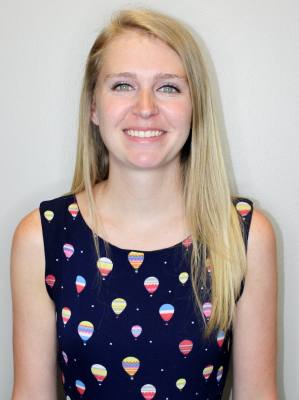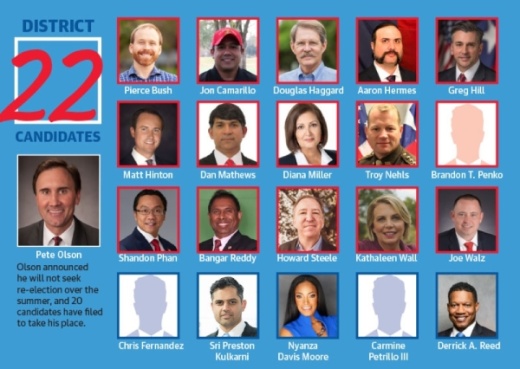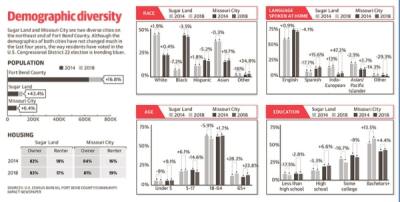Roughly half of the candidates running for District 22 in the March 3 primaries are from Fort Bend County, and a majority of those candidates are from Sugar Land, according to the Texas secretary of state’s office.
Voters will find 15 Republican candidates and five Democratic candidates on the March 3 primary election ballot.
“That’s Fort Bend County with all the growth and all the diversity,” Olson said. “That shows people are paying attention.”
Crossing party lines
In the last election cycle for District 22 in 2018, Olson’s Democratic challenger, Sri Preston Kulkarni, nearly ousted Olson, garnering 46.4% of votes in the entire district.“Democrats have seen success, so they are going to want to build on that,” said Brandon Rottinghaus, a political science professor at the University of Houston. “Republicans have seen some slumping, and they are going to want to get it back.”
In 2018, Fort Bend County, known for its diverse population, had a racial demographic breakdown of 24% Hispanic, 34% white, 20% black and 20% Asian. This was fairly consistent with the data from 2014, according to the U.S. Census Bureau.
However, in November 2018, 46.7% of voters in Fort Bend County voted for the Democratic candidate in the District 22 election. In November 2014, the same race saw 30.2% of voters select the Democratic choice.
“I think that we are shifting,” said Cynthia Ginyard, the chair of the Fort Bend County Democratic Party. “The proof of that is in the results that we got in 2018. Fort Bend continues to grow. As it continues to grow, the new growth is not red, totally. Therefore, we’re looking probably at a solidly purple county. Of course, our goal is to make it blue.”
However, Linda Howell, the Fort Bend County Republican Party Chair, said she thinks diversity has contributed to the long list of Republicans running in the District 22 race.
“The interesting thing to me is we have a large group of diverse candidates, and they actually selected the Republican Party to run in because our values are the same,” Howell said.
Howell also said she thinks the county will remain red.
“I think it may look like [Fort Bend County is turning blue] with the last election, but I think it also woke up, in a sense, these different diverse communities to say, ‘We love our county; we love the direction it’s going; we don’t want it to change,’” she said.
Ginyard said because Kulkarni came so close to taking the District 22 seat in 2018, she thinks it is entirely possible a Democrat could win the seat in 2020.
“It is now deemed a seat that is winnable, and that may not have been the case five years ago,” Ginyard said.
As more people move into Houston’s western suburbs, they are increasingly younger, nonwhite and more Democratic, said Robert Stein, a political expert at Rice University. They are also voting at higher rates.
“That is a very bad sign for Republicans,” Stein said. “[Young and more diverse voters] are replacing older white voters who are dying.”
Fort Bend County Judge KP George, a Democrat, said this demographic shift is felt in his county. Both he and Fort Bend County Precinct 4 Commissioner Ken DeMerchant, another Democrat, unseated longtime Republicans on the court in 2018.
“With people from all walks of life, a wide berth of issues must be addressed at all levels—from municipal utility districts to school boards to Congress—because representation matters,” George said.
Party priorities
There are three times as many Republicans in the running compared to the number of Democrats who have filed. But come November—after the March primaries and any runoff elections—one Republican will face one Democrat on the ballot.“Of course, our ultimate goal is to beat the Democratic candidate,” Howell said. “We want to keep this a Republican seat. I’m very excited that our voters are going to have an opportunity to vote for some great candidates.
As Olson prepares to end his term, he said he feels some of the biggest challenges facing District 22 include transportation issues and flood prevention.
Howell said the Fort Bend County Republican Party prioritizes increasing border security, stopping the spread of socialism and focusing on the issue with Iran.
“Probably the No. 1 issue could be the law enforcement partnering with [U.S. Immigration and Customs Enforcement] to deport our illegal aliens who are committing crimes such as drug trafficking and human trafficking,” Howell said.
Ginyard said illegal immigration is not a concern of the Fort Bend Democratic Party because what is portrayed right now is all negative.
Ginyard also said the Fort Bend County Democratic Party feels issues such as access to health care, education on climate change and equality for women are priorities.
“I can’t think of an issue that is [District] 22 specific,” she said. “But I believe that equity issues across the board affect all people.”
Something both sides can agree on is maintaining democracy.
“I don’t speak to socialism, but I do know we love democracy,” Ginyard said. “This country was built on democracy. ... So we don’t subscribe to those concerns.”
Olson said his decision not to seek re-election is rooted in wanting to spend more time with his family. He also said he wants to see Fort Bend County continue to grow both in size and in diversity in the years to come.
“I just want the growth to keep going on,” Olson said. “It’s been controlled growth, but it’s been great growth. I just want us to embrace our diversity. We had a big change in the last election cycle. The Democrats took over some seats, but there was not a blip in terms of how the county kept operating. We kept uniting.”
Nola Z. Valente contributed to this report.







